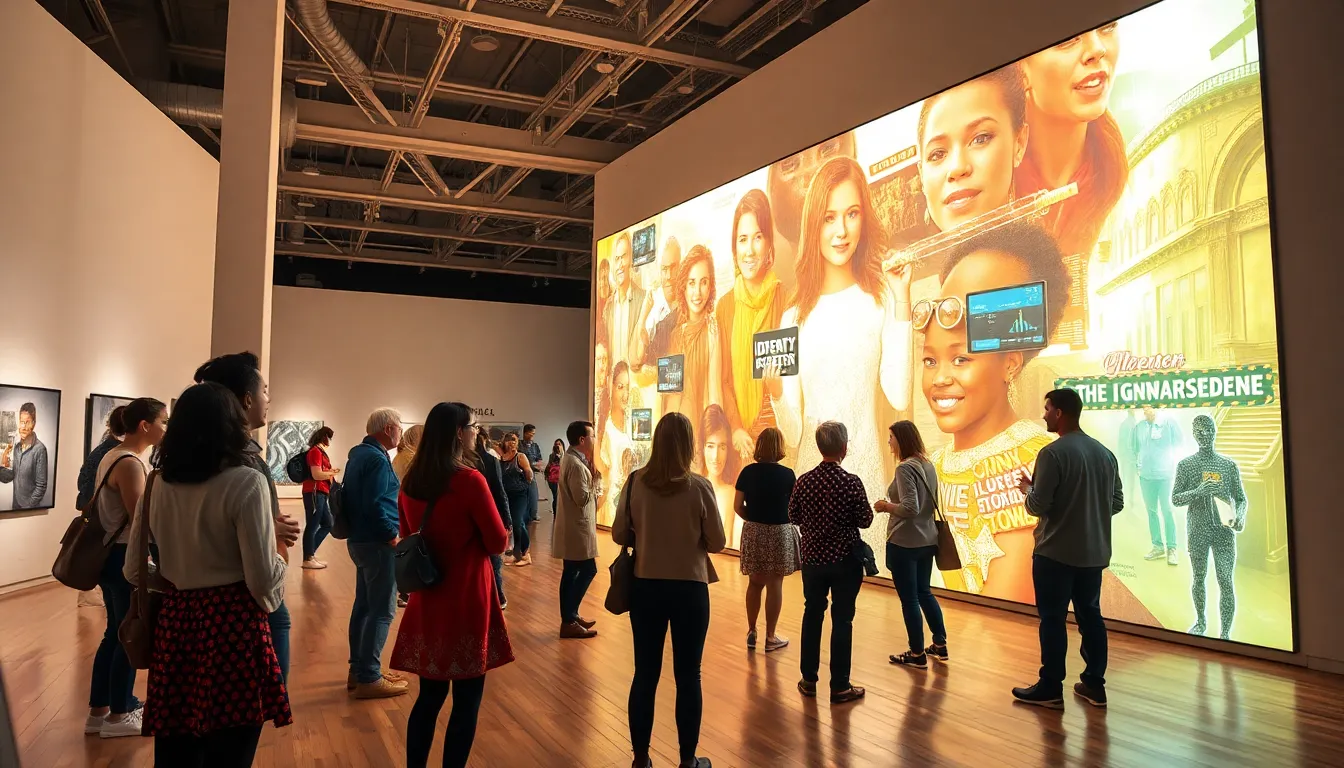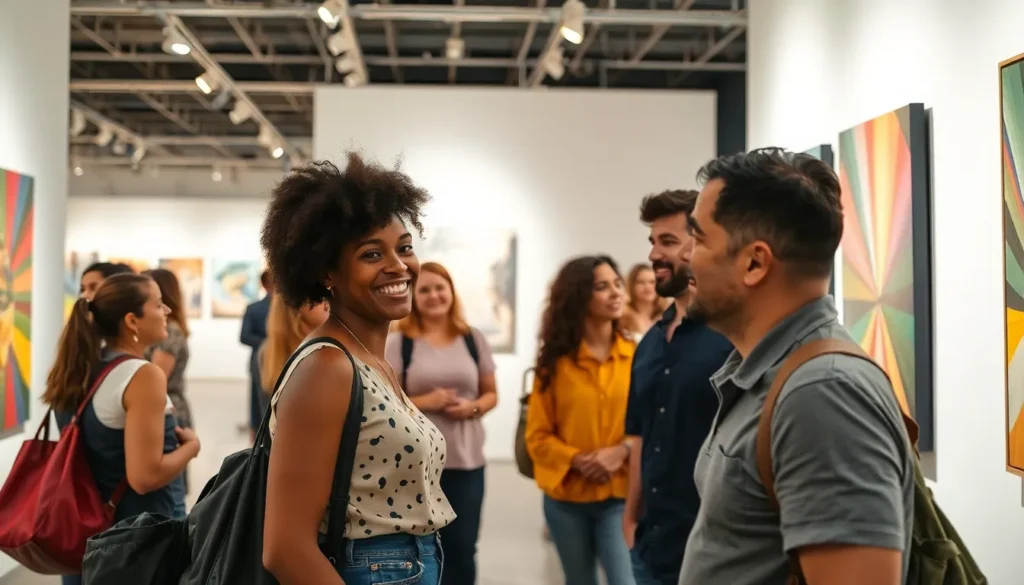Table of Contents
ToggleArt exhibits are like a buffet for the soul, offering a feast of creativity that can leave anyone inspired. Whether it’s a contemporary installation that makes you question reality or a classic painting that whispers tales of the past, these showcases have a knack for pulling people in. They’re not just for the elite art critics; they’re for anyone who’s ever stared at a blank wall and thought, “I could do better… or at least I’d like to try!”
Overview of Art Exhibits
Art exhibits serve as a reflection of cultural diversity. Various art forms, such as painting, sculpture, and multimedia installations, combine to create immersive experiences. They attract viewers from different backgrounds, engaging them with unique perspectives and creativity.
Exhibitors often curate collections that emphasize specific themes or artists. Curatorial choices can highlight social issues, historical contexts, or artistic movements. Popular exhibits, such as large-scale installations or interactive experiences, tend to draw larger crowds. This engagement fosters dialogue among visitors, encouraging them to share their thoughts and interpretations.
Art exhibits may also incorporate educational components. Workshops, guided tours, and artist talks can enhance the visitor experience. Many venues aim to bridge the gap between artists and the public, facilitating a deeper understanding of artistic intentions.
Accessibility remains a priority for many galleries and museums. Efforts to provide both physical accessibility and multilingual resources ensure a broader audience can enjoy the exhibits. Local community involvement can further enrich the exhibits, creating opportunities for emerging artists.
Seasonal and temporary exhibits add freshness to the art landscape. Each show provides an opportunity for audiences to discover new talents and forgotten masterpieces alike. Engaging with art exhibits fosters exploration, creativity, and broader cultural conversations, making them vital to contemporary society.
Types of Art Exhibits

Art exhibits come in various forms, each offering unique perspectives and experiences for visitors. Two prominent types are contemporary and historical art exhibits.
Contemporary Art Exhibits
Contemporary art exhibits showcase modern works by living artists, often pushing creative boundaries. Installations, paintings, and multimedia presentations dominate these spaces. Visitors often encounter themes like identity, technology, or environmental issues. Artists aim to provoke thought and encourage dialogue around current societal topics. Events such as artist talks and workshops frequently accompany these exhibits, enhancing engagement and understanding.
Historical Art Exhibits
Historical art exhibits feature pieces from different eras, providing insight into cultural movements. Such exhibits often include famous paintings, sculptures, and artifacts that reflect historical contexts. Contextual information enhances appreciation, helping visitors connect emotionally with artworks. Curators focus on specific themes or artists, pairing works to illustrate influences across time and place. Educational programs often accompany these exhibits, enriching the visitor experience with deeper historical knowledge.
Importance of Art Exhibits
Art exhibits play a vital role in cultural expression and education. They invite individuals to engage with diverse art forms and ideas.
Cultural Significance
Art exhibits represent cultural narratives that resonate with varied communities. They reflect social issues and historical events expressed through visual mediums. Artists often explore themes like identity and heritage. Viewers from different backgrounds can connect with shared experiences and cultural pride. Such exhibits foster dialogue among attendees, promoting understanding and empathy. Public engagement becomes a priority as these showcases include local artists and community contributions, enriching the cultural landscape.
Educational Value
Art exhibits serve as dynamic educational platforms that enhance knowledge and appreciation of art. Workshops and talks enable deeper interactions with artists, offering insights into creative processes. Contextual information presented alongside artworks helps visitors grasp historical and cultural significance. Curated educational programs target diverse audiences, catering to students, teachers, and art enthusiasts. Opportunities for hands-on learning increase engagement and understanding. Exhibits thus bridge the gap between art and the public, cultivating an informed audience that values artistic endeavors.
Notable Art Exhibits Worldwide
Art exhibits attract diverse audiences and celebrate global creativity. Various events and institutions showcase exceptional talent and cultural narratives.
Major Art Festivals
Art festivals spotlight contemporary and historical artworks, creating vibrant public experiences. Events such as the Venice Biennale, held since 1895, recognize international artists and innovative installations. The Art Basel fair provides a platform for leading galleries, offering a blend of modern and contemporary art. Similarly, the Frieze Art Fair showcases works from established and emerging artists, generating significant buzz within the art community. Each festival emphasizes collaboration and dialogue, encouraging creative exchanges among attendees and artists.
Renowned Museums
Renowned museums across the globe house significant art collections and host captivating exhibits. The Louvre in Paris, known for its masterpiece the Mona Lisa, offers visitors a glimpse into art history across centuries. New York’s Museum of Modern Art (MoMA) showcases contemporary works, emphasizing movements like Impressionism and Abstract Expressionism. The British Museum, based in London, presents artifacts reflecting world cultures, with highlights from Ancient Egypt to the present day. Each museum’s curated exhibits provide educational insights and foster appreciation for diverse artistic heritages.
Tips for Attending Art Exhibits
Attending art exhibits offers an opportunity to explore creativity and cultural diversity. Visitors should be prepared for immersive experiences that engage their senses.
What to Expect
Expect variety in artwork, including contemporary installations and historical pieces. Curators often highlight specific themes or artists, guiding viewers in their exploration. Educational components, like workshops and artist talks, enrich the experience. Visitors may encounter multimedia installations that challenge traditional boundaries. Each exhibit aims to evoke dialogue among attendees and promote cultural understanding. Accessibility remains a priority, ensuring everyone can enjoy diverse artistic expressions.
How to Engage with the Art
Engagement with art starts by observing details in each piece, such as color, texture, and form. Visitors can ask open-ended questions to spark conversations, whether with fellow attendees or gallery staff. It helps to attend artist talks for deeper insights into the creative process and intentions behind the artwork. Jotting down thoughts or reflections encourages personal connections with the pieces. Sharing experiences on social media platforms can foster further dialogue and appreciation for the exhibited works. Embrace the chance to explore differing perspectives while absorbing the narratives that art presents.
Art exhibits are more than just displays of creativity; they’re gateways to understanding diverse cultures and perspectives. By inviting everyone to engage with art, these showcases foster a sense of community and dialogue. Whether through contemporary pieces that challenge norms or historical collections that tell stories of the past, art exhibits enrich lives and broaden horizons.
The educational aspects of these events enhance the experience, making art accessible to all. Visitors can explore their own creativity while connecting with the narratives behind each piece. Ultimately, art exhibits play a vital role in shaping cultural conversations and inspiring individuals to appreciate the beauty of artistic expression.



